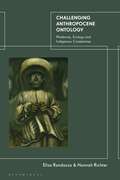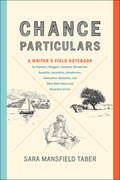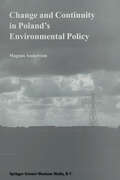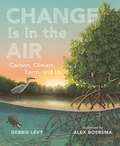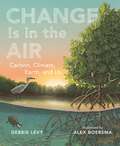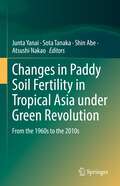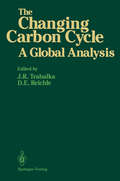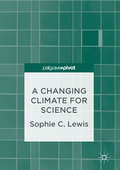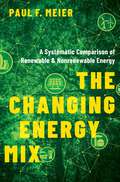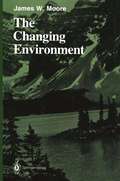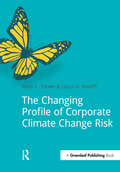- Table View
- List View
Challenging Anthropocene Ontology: Modernity, Ecology and Indigenous Complexities
by Dr Elisa Randazzo Dr Hannah RichterUsing the recent turn to ecology as a starting point, Hannah Richter and Elisa Randazzo bring ecological thinking into contact with Critical Indigenous Studies, in which awareness of the necessity for sustainable relations between humans and non-humans has long preceded Western Anthropocene discourse. Currently, the drastic ecological changes labelled as 'the Anthropocene' not only increasingly shape the political awareness and the priorities of citizens and governments, but also inform a large body of social scientific scholarship. Indigenous scholarship and practice, in particular ecological adaptability, is intrinsically related to power structures and political struggle – hence indigenous understanding of Anthropocene discourses are intertwined with discourses of colonialism and political contestation. This book problematises the depoliticising character of Western Anthropocene discourses in relation to indigenous ecologies. The authors reveal how the anti-colonial struggles of Indigenous communities and the unequal distribution of responsibilities for and suffering from ecological change, are concealed and devalued in Western discourses of the Anthropocene.
Challenging Consumption: Pathways to a more Sustainable Future (Routledge Studies in Sustainability)
by Anna R. Davies Frances Fahy Henrike RauSustainable consumption is a central research topic in academic discourses of sustainable development and global environmental change. Informed by a number of disciplinary perspectives, this book is structured around four key themes in sustainable consumption research: Living, Moving, Dwelling and Futures. The collection successfully balances theoretical insights with grounded case studies, on mobility, heating, washing and eating practices, and concludes by exploring future sustainable consumption research pathways and policy recommendations. Theoretical frameworks are advanced throughout the volume, especially in relation to social practice theory, theories of behavioural change and innovative visioning and backcasting methodologies. This groundbreaking book draws on some conceptual approaches which move beyond the responsibility of the individual consumer to take into account wider social, economic and political structures and processes in order to highlight both possibilities for and challenges to sustainable consumption. This approach enables students and policy-makers alike to easily recognise the applicability of social science theories.
Challenging Consumption: Pathways to a more Sustainable Future (Routledge Studies in Sustainability)
by Anna R. Davies Frances Fahy Henrike RauSustainable consumption is a central research topic in academic discourses of sustainable development and global environmental change. Informed by a number of disciplinary perspectives, this book is structured around four key themes in sustainable consumption research: Living, Moving, Dwelling and Futures. The collection successfully balances theoretical insights with grounded case studies, on mobility, heating, washing and eating practices, and concludes by exploring future sustainable consumption research pathways and policy recommendations. Theoretical frameworks are advanced throughout the volume, especially in relation to social practice theory, theories of behavioural change and innovative visioning and backcasting methodologies. This groundbreaking book draws on some conceptual approaches which move beyond the responsibility of the individual consumer to take into account wider social, economic and political structures and processes in order to highlight both possibilities for and challenges to sustainable consumption. This approach enables students and policy-makers alike to easily recognise the applicability of social science theories.
Chance Particulars: A Writer's Field Notebook for Travelers, Bloggers, Essayists, Memoirists, Novelists, Journalists, Adventurers, Naturalists, Sketchers, and Other Note-Takers and Recorders of Life
by Sara Mansfield TaberThe goal of the writer is to live with the keenness of the foreigner. To experience, wide-eyed, the sensations aroused and the events offered up by peculiar surrounds and then to evoke them so brightly on the page that the reader, too, experiences the foreigner;€™s frisson. A time-honored way this is accomplished is through the keeping of a field notebook;¢;‚¬;€?through the faithful recording of the this-and-that of life; the atmospheres and incidents; the bells, the beer, the bread.Based on what accomplished nonfiction writer Sara Mansfield Taber learned in her many years of field notebook keeping, Chance Particulars is a unique and handy primer for writers who want to use their experiences to tell a lively, satisfying story. Often, writers try to turn their notes into a memoir, essay, travel piece, or story, only to find that they haven;€™t recorded enough of the concrete, sensory details necessary to create evocative description. To help writers overcome this problem, Taber has composed a true "field notebook for field notebook keepers." Enhanced by beautiful illustrations, this charming and comprehensive guide is a practical manual for anyone who wishes to learn or hone the crafts of writing, ethnography, or journalism.Writers of all levels, genres, and ages, as well as teachers of writing, will appreciate this useful tool for learning how to record the details that build vibrant prose. With this book in hand, you will be able to recreate times and places, conjure up intricate character portraits, and paint pictures of particular landscapes, cultures, and locales.
Chance Particulars: A Writer's Field Notebook for Travelers, Bloggers, Essayists, Memoirists, Novelists, Journalists, Adventurers, Naturalists, Sketchers, and Other Note-Takers and Recorders of Life
by Sara Mansfield TaberThe goal of the writer is to live with the keenness of the foreigner. To experience, wide-eyed, the sensations aroused and the events offered up by peculiar surrounds and then to evoke them so brightly on the page that the reader, too, experiences the foreigner;€™s frisson. A time-honored way this is accomplished is through the keeping of a field notebook;¢;‚¬;€?through the faithful recording of the this-and-that of life; the atmospheres and incidents; the bells, the beer, the bread.Based on what accomplished nonfiction writer Sara Mansfield Taber learned in her many years of field notebook keeping, Chance Particulars is a unique and handy primer for writers who want to use their experiences to tell a lively, satisfying story. Often, writers try to turn their notes into a memoir, essay, travel piece, or story, only to find that they haven;€™t recorded enough of the concrete, sensory details necessary to create evocative description. To help writers overcome this problem, Taber has composed a true "field notebook for field notebook keepers." Enhanced by beautiful illustrations, this charming and comprehensive guide is a practical manual for anyone who wishes to learn or hone the crafts of writing, ethnography, or journalism.Writers of all levels, genres, and ages, as well as teachers of writing, will appreciate this useful tool for learning how to record the details that build vibrant prose. With this book in hand, you will be able to recreate times and places, conjure up intricate character portraits, and paint pictures of particular landscapes, cultures, and locales.
Change and Continuity in Poland’s Environmental Policy (Environment & Policy #20)
by Magnus AnderssonThis book takes a long-term view of environmental policy in Poland, which thus serves as an example to increase our understanding of environmental policy making in general in the former Eastern bloc countries. The perspective adopted also includes the pre-transition period, since the transformation process cannot be understood without reference to the preceding period. The book investigates the driving forces underlying policy changes, both prior to and after the transition, and identifies elements both of change and continuity - topics that have hitherto been neglected in the literature. A change of political system in Poland did not lead to a major change in the thrust of environmental policy: the policy makers adopted a cautious approach to new instruments and institutions during the transition period. What did change with the transition was the implementation aspect: the effectiveness of environmental policy increased dramatically after the abolition of socialism. The rule of law meant that the state administration and the polluters were subordinated to the legal system, thus increasing the power to environmental policy. Readership: Researchers and students interested in the environment and the countries in transition.
Change Is in the Air: Carbon, Climate, Earth, and Us
by Debbie LevyA nonfiction picture book about amazing ways that the Earth removes carbon from the air, and amazing ways people can help, offering a fresh and hopeful perspective on climate change.The Earth has a problem: there's too much carbon in the air. Luckily, the Earth also has amazing powers to remove carbon dioxide from the atmosphere-like the power of kelp, mangroves, and dirt. Although these powers alone cannot get us out of the climate crisis we're facing, the Earth has another important power: the power of people! People have the power to change, protect, innovate, and invent. In this informational picture book, Debbie Levy and Alex Boersma paint an encouraging yet honest picture of the problems at hand and some of the ways that we can address them. Thanks to the power of nature and the ingenuity of people, change is in the air!
Change Is in the Air: Carbon, Climate, Earth, and Us
by Debbie LevyA nonfiction picture book about amazing ways that the Earth removes carbon from the air, and amazing ways people can help, offering a fresh and hopeful perspective on climate change.The Earth has a problem: there's too much carbon in the air. Luckily, the Earth also has amazing powers to remove carbon dioxide from the atmosphere-like the power of kelp, mangroves, and dirt. Although these powers alone cannot get us out of the climate crisis we're facing, the Earth has another important power: the power of people! People have the power to change, protect, innovate, and invent. In this informational picture book, Debbie Levy and Alex Boersma paint an encouraging yet honest picture of the problems at hand and some of the ways that we can address them. Thanks to the power of nature and the ingenuity of people, change is in the air!
Changes In The Land: Indians, Colonists, And The Ecology Of New England (PDF)
by William Cronon John DemosWinner of the Francis Parkman Prize Changes in the Landoffers an original and persuasive interpretation of the changing circumstances in New England's plant and animal communities that occurred with the shift from Indian to European dominance. With the tools of both historian and ecologist, Cronon constructs an interdisciplinary analysis of how the land and the people influenced one another, and how that complex web of relationships shaped New England's communities.
Changes in Paddy Soil Fertility in Tropical Asia under Green Revolution: From the 1960s to the 2010s
by Junta Yanai Sota Tanaka Shin Abe Atsushi NakaoThis book investigates the effect of the Green Revolution (GR) on long-term changes in the fertility status of paddy soils in tropical Asia. While information on long-term changes in soil fertility status are rather limited due to difficulties in obtaining past data or samples for comparison, this investigation on temporal changes in soil fertility is possible by comparing fertility status in the 2010s, which the authors examined recently, with those from the 1960s, when GR was initiated, which was reported by Kawaguchi & Kyuma (1977). More than 220 paddy soils collected from Thailand, the Philippines, Malaysia, Bangladesh, and Indonesia were analyzed for their physicochemical properties as well as total and available fractions of plant macro- and micro- essential elements, and their temporal changes were examined in addition to their spatial variation in each country. The most significant change was a drastic increase of available phosphorus in soils, possibly due to fertilization after the GR. Changes in organic matter, pH, and other nutrients were relatively small. A considerable decrease in the content of some micronutrients was also observed. Long-term studies on soil fertility status in the past and present will be useful to establish soil/fertilizer management for sustainable rice production in the future. This book is an essential reading for soil scientists, agricultural scientists, environmental scientists, as well as policymakers and nongovernmental officers such as FAO.
Changes of Atmospheric Chemistry and Effects on Forest Ecosystems: A Roof Experiment without a Roof (Nutrients in Ecosystems #3)
by Reinhard F. HüttlThis volume summarises the result of an interdisciplinary research programme entitled `Rehabilitation of the Atmosphere of the New States of Germany - Effects on Terrestrial Ecosystems'. Before the unification of Germany, emission loads of SO2 and dust particles were up to 18-fold higher in East than in West Germany. However, emission rates have decreased significantly since reunification in 1990, due to the breakdown of a large number of industrial and particularly lignite- fired powerplants and the implementation of clean air technologies. In order to study the effects of these dramatic changes in atmospheric chemistry on terrestrial ecosystems, comprehensive field studies were conducted in pine forest ecosystems along an historic gradient of atmospheric deposition rates in the northeastern lowlands of Germany. The fast and dramatic reduction of dust particle and SO2 emissions offers a unique opportunity to test the role of SO2 and alkaline particle deposition with regard to changes or damage to forest ecosystems and whether the forest stands return to a state of resilience. In this respect, this ecosystem experiment can be looked upon as a roof experiment without a roof.
The Changing Arctic: Consensus Building and Governance in the Arctic Council
by D. NordOver the last few years the Arctic has become a region of growing interest to the international community. Major environmental, economic, social, and security issues are all in evidence within its borders today. Many feel that there is an urgent need to establish an effective governance structure for the area. The Arctic Council has offered a basic forum for circumpolar consultation and cooperation over the past two decades. However, it has not been an easy undertaking and the organization has had to wrestle with a series of internal and external impediments that have hindered its forward progress. This volume explores the efforts of Sweden, a recent Chair of the Arctic Council, to build an enhanced framework for consensus-building and governance within the circumpolar region. It examines its efforts to provide focused leadership for the Arctic Council and to advance the environmental protection and sustainable development missions of the organization. It considers the various means by which Sweden utilized its position as chair of the Arctic Council to promote its program for action in both these areas. It also explores how this leadership position enabled it to foster necessary organizational reform within the body. The book gives new insight into how both the formal and informal 'powers of the chair' can be utilized to facilitate institutional growth and change. It also provides new and useful understanding of how a small country like Sweden can harness key elements of 'soft power' to advance its foreign policy objectives in the Arctic. The author closely followed the undertakings of the Swedish Chairmanship team over its two years at the helm of this emerging Arctic international organization. He witnessed its several successes and a few of its disappointments. The volume offers a behind the scene view of the challenges and opportunities faced by contemporary diplomats as they pursue their efforts at international organization.
Changing by Degrees: The Potential Impacts of Climate Change in the East Midlands (Routledge Studies in Environmental Policy and Practice)
by Simon Shackley Jim Kersey Paul FlemingIt is now accepted that the world’s climate has warmed by about 0.5°C over the past one hundred years and will continue to warm by as much as 6°C by the end of the current century. What, however, do such fundamental changes actually mean for life and the economy at the local and regional scales for the industrialized nations? This extensive study represents a state-of-the-art regional assessment of the impacts of climate change in an industrialized European nation. Providing a comprehensive set of tools, techniques and strategies, it explores the potential impacts of climate change upon key landscapes, economic and social sectors.
Changing by Degrees: The Potential Impacts of Climate Change in the East Midlands (Routledge Studies in Environmental Policy and Practice)
by Simon Shackley Jim Kersey Paul FlemingIt is now accepted that the world’s climate has warmed by about 0.5°C over the past one hundred years and will continue to warm by as much as 6°C by the end of the current century. What, however, do such fundamental changes actually mean for life and the economy at the local and regional scales for the industrialized nations? This extensive study represents a state-of-the-art regional assessment of the impacts of climate change in an industrialized European nation. Providing a comprehensive set of tools, techniques and strategies, it explores the potential impacts of climate change upon key landscapes, economic and social sectors.
The Changing Carbon Cycle: A Global Analysis
by David E. Reichle John R. TrabalkaThe United States Government, cognizant of its responsibilities to future generations, has been sponsoring research for nine years into the causes, effects, and potential impacts of increased concentrations of carbon dioxide (C0 ) in the atmosphere. Agencies such as the National Science Foun 2 dation, National Oceanic and Atmospheric Administration, and the U.S. Department of Energy (DOE) cooperatively spent about $100 million from FY 1978 through FY 1984 directly on the study of CO • The DOE, as the 2 lead government agency for coordinating the government' s research ef forts, has been responsible for about 60% of these research efforts. William James succinctly defined our purpose when he stated science must be based upon " ... irreducible and stubborn facts." Scientific knowledge can and will reduce the present significant uncertainty sur rounding our understanding of the causes, effects, and potential impacts of increasing atmospheric CO2• We have come far during the past seven years in resolving some underlyinig doubts and in narrowing the ranges of disagreement. Basic concepts have become less murky. Yet, much more must be accomplished; more irreducible and stubborn facts are needed to reduce the uncertainties so that we can improve our knowledge base. Uncertainty can never be reduced to zero. However, with a much improved knowledge base, we will be able to learn, under stand, and be in a position to make decisions.
Changing Climate, Changing Worlds: Local Knowledge and the Challenges of Social and Ecological Change (Ethnobiology)
by Meredith Welch-Devine Anne Sourdril Brian J. BurkeThis book explores how individuals and communities perceive and understand climate change using their observations of change in the world around them. Because processes of climatic change operate at spatial and temporal scales that differ from those of everyday practice, the phenomenon can be difficult to understand. However, flora and fauna, which are important natural and cultural resources for human communities, do respond to the pressures of environmental change. Humans, in turn, observe and adapt to those responses, even when they may not understand their causes. Much of the discussion about human experiences of our changing climate centers on disasters and extreme events, but we argue that a focus on the everyday, on the microexperiences of change, has the advantage of revealing how people see, feel, and make sense of climate change in their own lives. The chapters of this book are drawn from Asia, Europe, Africa, and South and North America. They use ethnographic inquiry to understand local knowledge and perceptions of climate change and the social and ecological changes inextricably intertwined with it. Together, they illustrate the complex process of coming to know climate change, show some of the many ways that climate change and our responses to it inflict violence, and point to promising avenues for moving toward just and authentic collaborative responses.
A Changing Climate for Science
by Sophie C. LewisThis book offers a critical exploration of first-hand experiences of practicing climate science. It tackles the pivotal question of what, precisely, constitutes contemporary scientific practice. The author offers an insider’s account of the experience of undertaking scientific training and of practicing as a climate scientist in order to examine the gulf between the way that science is perceived and pursued. Lewis delves into this discrepancy, drawing on personal experiences, recent scientific studies, extreme climatic events and political controversies. The book begins by considering the relevance of key concepts such as knowability, credibility, authority and objectivity to the practice of climate science. The following chapters argue that these concepts alone are limiting to our critical understanding climate science and climate change. The book then proposes a new view of scientific practice appropriate for diverse disciplines by arguing that concepts such as transparency and curiosity are equally important to scientific practice as the more familiar key concepts introduced at the start of the book. This book will appeal to climate scientists, social scientists and those interested in the challenges posed by future climate change.
A Changing Climate for Science
by Sophie C. LewisThis book offers a critical exploration of first-hand experiences of practicing climate science. It tackles the pivotal question of what, precisely, constitutes contemporary scientific practice. The author offers an insider’s account of the experience of undertaking scientific training and of practicing as a climate scientist in order to examine the gulf between the way that science is perceived and pursued. Lewis delves into this discrepancy, drawing on personal experiences, recent scientific studies, extreme climatic events and political controversies. The book begins by considering the relevance of key concepts such as knowability, credibility, authority and objectivity to the practice of climate science. The following chapters argue that these concepts alone are limiting to our critical understanding climate science and climate change. The book then proposes a new view of scientific practice appropriate for diverse disciplines by arguing that concepts such as transparency and curiosity are equally important to scientific practice as the more familiar key concepts introduced at the start of the book. This book will appeal to climate scientists, social scientists and those interested in the challenges posed by future climate change.
Changing Climates, Earth Systems and Society (International Year of Planet Earth)
by John DodsonThe International Year of Planet Earth (IYPE) was established as a means of raising worldwide public and political awareness of the vast, though frequently under-used, potential the Earth Sciences possess for improving the quality of life of the peoples of the world and safeguarding Earth’s rich and diverse environments. The International Year project was jointly initiated in 2000 by the International Union of Geological Sciences (IUGS) and the Earth Science Division of the United Nations Educational, Scienti?c and Cultural Organisation (UNESCO). IUGS, which is a Non-Governmental Organisation, and UNESCO, an Inter-Governmental Organisation, already shared a long record of productive cooperation in the na- ral sciences and their application to societal problems, including the International Geoscience Programme (IGCP) now in its fourth decade. With its main goals of raising public awareness of, and enhancing research in the Earth sciences on a global scale in both the developed and less-developed countries of the world, two operational programmes were demanded. In 2002 and 2003, the Series Editors together with Dr. Ted Nield and Dr. Henk Schalke (all four being core members of the Management Team at that time) drew up outlines of a Science and an Outreach Programme. In 2005, following the UN proclamation of 2008 as the United Nations International Year of Planet Earth, the “Year” grew into a triennium (2007–2009).
Changing Climates, Ecosystems and Environments within Arid Southern Africa and Adjoining Regions: Palaeoecology of Africa 33
by Jörgen RungeThis book is volume 33 of the yearbook seriesPalaeoecology of Africa presenting the outcome of atribute conference to the internationally recognized South African researcher and palynologist Professor Louis Scott. He has recently retired, but is continuing his active research career. The conference proceedings and articles published here
The Changing Energy Mix: A Systematic Comparison of Renewable and Nonrenewable Energy
by Paul MeierEnergy comes in many shapes and forms, from wind, solar power, geothermal, and biomass to coal, natural gas, and petroleum. The energy we consume is constantly changing, but the use of these resources-whether renewable or nonrenewable-has long-term impacts on our planet. While there has been this recent shift to renewable energy within the United States, the worldwide demand for all energy types continues to increase at a rapid rate. In fact, it has increased by 84% over the past twenty years. Despite their dwindling supply, these resources are still heavily relied on today. Coal still accounts for 30% of the electricity generated by the United States, even though natural gas is now the primary energy used to produce electricity. Likewise, only 7% of electricity usage worldwide is linked to solar and wind energy. In The Changing Energy Mix, Paul F. Meier compares twelve renewable and nonrenewable energy types using twelve common technical criteria. These criteria span projected reserves, cost to the consumer and supplier, energy balances, environmental issues, land area required, and lasting impacts. While explaining the pros and cons of these resources, Meier takes readers through the history of energy in the United States and world. He provides insight into energy sources, such as wind-powered and solar-powered electricity (which did not exist until the mid and late 80s, respectively), and he explains the constantly evolving world of energy. Breaking down the potential promises and struggles of transitioning to a more renewable energy-based economy, Meier explains the positive and negative implications of these various sources of energy. The resulting book equips readers with a unique understanding of the history, availability, technology, implementation cost, and concerns of renewable and nonrenewable energy.
The Changing Energy Mix: A Systematic Comparison of Renewable and Nonrenewable Energy
by Paul MeierEnergy comes in many shapes and forms, from wind, solar power, geothermal, and biomass to coal, natural gas, and petroleum. The energy we consume is constantly changing, but the use of these resources-whether renewable or nonrenewable-has long-term impacts on our planet. While there has been this recent shift to renewable energy within the United States, the worldwide demand for all energy types continues to increase at a rapid rate. In fact, it has increased by 84% over the past twenty years. Despite their dwindling supply, these resources are still heavily relied on today. Coal still accounts for 30% of the electricity generated by the United States, even though natural gas is now the primary energy used to produce electricity. Likewise, only 7% of electricity usage worldwide is linked to solar and wind energy. In The Changing Energy Mix, Paul F. Meier compares twelve renewable and nonrenewable energy types using twelve common technical criteria. These criteria span projected reserves, cost to the consumer and supplier, energy balances, environmental issues, land area required, and lasting impacts. While explaining the pros and cons of these resources, Meier takes readers through the history of energy in the United States and world. He provides insight into energy sources, such as wind-powered and solar-powered electricity (which did not exist until the mid and late 80s, respectively), and he explains the constantly evolving world of energy. Breaking down the potential promises and struggles of transitioning to a more renewable energy-based economy, Meier explains the positive and negative implications of these various sources of energy. The resulting book equips readers with a unique understanding of the history, availability, technology, implementation cost, and concerns of renewable and nonrenewable energy.
The Changing Environment: World-system History And Global Environmental Change (Springer Series on Environmental Management)
by James W. MooreThis series is dedicated to serving the growing community of scholars and practitioners concerned with the principles and applications of environmental management. Each volume is a thorough treatment of a specific topic of importance for proper management practices. A fundamental objective of these books is to help the reader discern and implement man's stewardship of our environment and the world's renewable resources. For we must strive to understand the relationship between man and nature, act to bring harmony to it, and nurture an environment that is both stable and productive. These objectives have often eluded us because the pursuit of other individual and societal goals has diverted us from a course of living in balance and the environment. At times, therefore, the environmental manager may have to exert restrictive control, which is usually best applied to man, not nature. Attempts to alter or harness nature have often failed or backfired, as exemplified by the results of imprudent use of herbicides, fertilizers, water, and other agents. Each book in this series will shed light on the fundamental and applied aspects of environmental management. It is hoped that each will help solve a practical and serious environmental problem.
Changing Forests: Collective Action, Common Property, and Coffee in Honduras
by Catherine M. TuckerDrawing on ethnographic and archival research, this book explores how the indigenous Lenca community of La Campa, Honduras, has conserved and transformed their communal forests through the experiences of colonialism, opposition to state-controlled logging, and the recent adoption of export-oriented coffee production. The book merges political ecology, collective-action theories, and institutional analysis to study how the people and forests have changed through various transitions.
The Changing Profile of Corporate Climate Change Risk
by Mark Trexler Laura KosloffThis book will help business executives to (1) rethink their perceptions of climate risk (2) evaluate whether their company is effectively positioned, and (3) make informed and prudent business decisions about climate change risk in an environment rife with policy uncertainty.Business risk associated with climate change is commonly assumed to be primarily policy driven. Many companies internalize the current stalemate over global climate policy into a perception that climate risk is no longer a critical issue. Business climate risks, however, include: Operational and Supply Chain (Physical) Risk, Brand Risk, Market-driven Structural Risk, Liability Risk.As national and global policy to materially reduce climate change is delayed, it is business-prudent to assume that the level of climate risk is increasing. Even if policy risk might seem lower today than a few years ago, political will can change quickly. Should physical impacts of climate change manifest in dramatic ways, for example, draconian climate policy is likely to follow quickly. These conditions create a complex and shifting business risk environment, and most companies either overlook or substantially underestimate key climate risks. How many companies, for example, are positioned for material climate change outcomes, whether physical or regulatory? Companies with little climate change exposure may not face much downside risk from taking a wait-and-see approach. For those with greater exposure, being "too late" to respond will mean costs and competitive impacts that could have been avoided. Being "too early," however, can mean being penalized later for actions that reduce a company’s emissions today, or competitive disadvantage from getting too far out in front of competitors.
